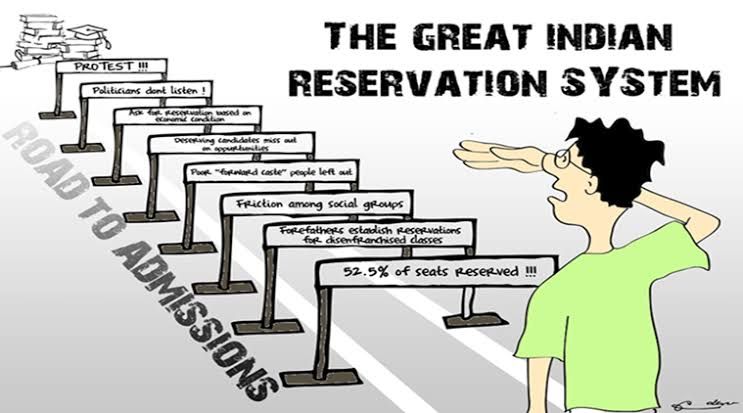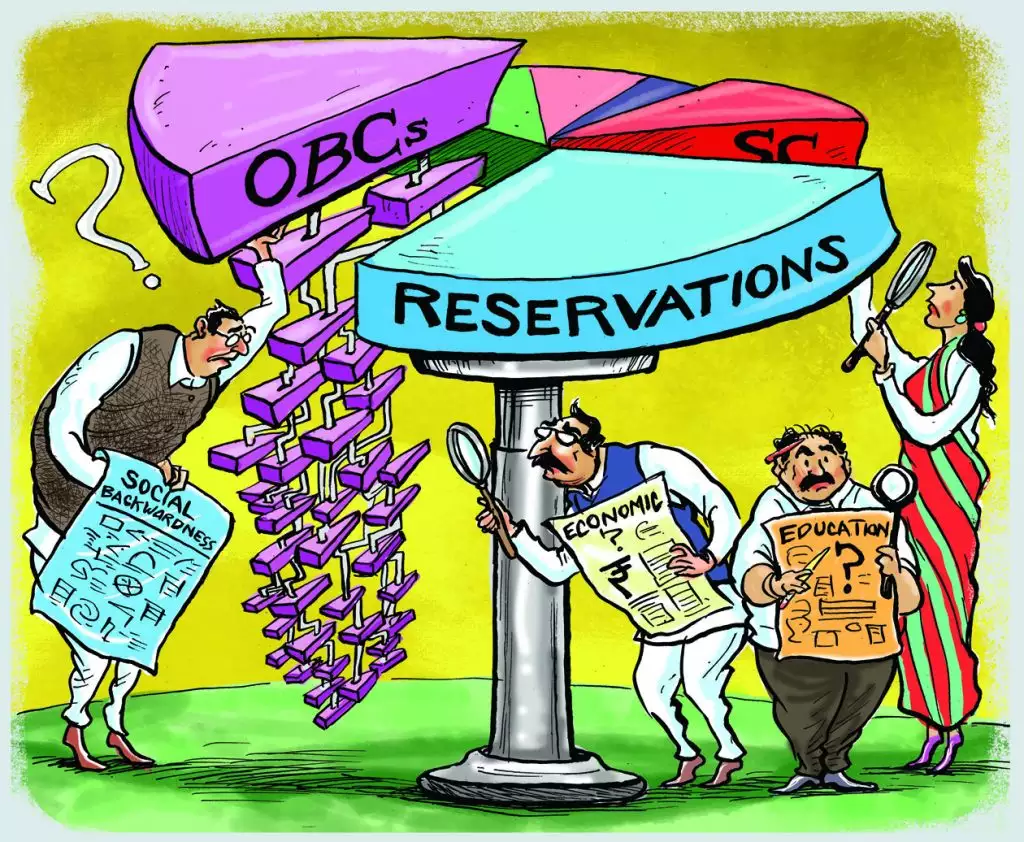Author- Jessica Singh Amethia, a Student of New Law College, Bharti Vidyapeeth Deemed to be University, Pune
Abstract:
Reservation policies in India have historically focused on public sector employment and education to uplift disadvantaged groups such as Scheduled Castes (SCs), Scheduled Tribes (STs), and Other Backward Classes (OBCs). Recently, the debate has shifted towards extending these policies to private sector employment, raising intricate legal, economic, and social issues. This article explores the historical context, constitutional provisions, and judicial interpretations of India’s reservation policies, and evaluates the pros and cons of private sector reservations. While extending reservations could promote social justice, inclusive growth, and corporate social responsibility, it also poses challenges to economic efficiency, legal compliance, and market dynamics. Through a legal perspective, the article discusses necessary constitutional amendments and policy considerations, supported by landmark case laws like Indra Sawhney, M. Nagaraj, and Ashoka Kumar Thakur. The conclusion advocates for a balanced approach that integrates diverse perspectives, ensures economic efficiency, and encourages voluntary corporate initiatives to foster social equity in India’s evolving socio-economic landscape.
- Introduction:
Reservation policies in India have long been a cornerstone of the country’s efforts to address historical injustices and promote social equity. These policies have traditionally been confined to public sector employment and educational institutions, where they aim to uplift socially and educationally backward classes, including Scheduled Castes (SCs), Scheduled Tribes (STs), and Other Backward Classes (OBCs). The debate over extending these reservations to the private sector has gained momentum, raising complex legal, economic, and social questions. This article provides a detailed examination of reservation policies in India, their potential extension to the private sector, and the associated implications.
- What is Reservation Policy in India and How It Works?
India’s reservation policy allocates a specific percentage of jobs and educational seats for Scheduled Castes (SC), Scheduled Tribes (ST), Other Backward Classes (OBC), and Economically Weaker Sections (EWS) in government institutions. This aims to achieve social justice by providing opportunities to historically disadvantaged communities.
- Historical Context and Objectives:
India’s reservation policy was initiated to address historical injustices and provide opportunities to Scheduled Castes (SCs), Scheduled Tribes (STs), and Other Backward Classes (OBCs). The constitutional provisions for reservation are primarily contained in Articles 15(4), 15(5), and 16(4) of the Indian Constitution, which allow the state to make special provisions for the advancement of these socially and educationally backward classes.
While these provisions have been predominantly applied in the public sector and educational institutions, the idea of extending reservations to the private sector gained traction in the early 2000s. The rationale was to ensure that affirmative action benefits extend to the burgeoning private sector, which has become a significant employer due to liberalization and economic reforms.
- Constitutional Provisions:
The key constitutional provisions related to reservations include:
- Article 15(4): Grants authority to the state to enact specific measures aimed at advancing socially and educationally disadvantaged groups, including Scheduled Castes (SCs) and Scheduled Tribes (STs).
- Article 15(5): Permits the state to implement special provisions to advance socially and educationally backward classes, as well as SCs and STs, particularly concerning admissions to educational institutions, which includes private institutions.
- Article 16(4): Allows for the reservation of appointments or posts in favor of any backward class of citizens that is underrepresented in state services.
- Article 46: Directs the state to promote with special care the educational and economic interests of the weaker sections of the people, particularly SCs and STs.
- Implementation Mechanism
Reservations in India are implemented through quotas that allocate a certain percentage of seats or job positions to the eligible communities. The current reservation structure in public sector employment typically includes:
Category
Reservation Percentage (Public Sector)
Description
Scheduled Castes (SC)
15%
A designated group historically facing untouchability and social exclusion.
Scheduled Tribes (ST)
7.5%
A designated group of indigenous communities facing marginalization.
Other Backward Classes (OBC)
27%
A diverse group identified as socially and educationally backward.
Economically Weaker Sections (EWS)
10%
A category created to provide reservation based on economic disadvantage, applicable across castes.
Total Reservation in Public Sector: 59.5% (As of 2024, exceeding the 50% cap in some states)
This structure is designed to ensure that these communities have access to opportunities that were historically denied to them due to systemic discrimination.
- Laws Related to Reservation:
- The Scheduled Castes and Scheduled Tribes (Prevention of Atrocities) Act, 1989: Provides protection to SCs and STs against discrimination and atrocities.
- The Central Educational Institutions (Reservation in Admission) Act, 2006: Mandates reservation in admissions for SCs, STs, and OBCs in central educational institutions.
- Judicial Interpretations
The Supreme Court of India has played a pivotal role in interpreting and shaping the reservation policy through landmark judgments:
- Indra Sawhney v. Union of India (1992): Upheld the constitutionality of reservations for OBCs but imposed a cap of 50% on the total reservations.
- M. Nagaraj v. Union of India (2006): Affirmed that reservations in promotions are permissible but subject to the criteria of backwardness, inadequacy of representation, and overall efficiency.
- Ashoka Kumar Thakur v. Union of India (2008): Upheld the 27% OBC reservation in educational institutions but excluded the “creamy layer” (the more affluent members) from the benefits.
- Reservation in the Private Sector: Pros and Cons:
A coin always has two sides and so does debates and arguments on reservation in private sector employment in India. Some pros and Cons include:
Pros/Arguments in Favour:
- Social Justice
- Promotion of Equality: Extending reservations to the private sector aims to redress historical injustices and discrimination faced by marginalized communities such as SCs, STs, and OBCs. By ensuring representation in private sector jobs, these policies can help level the playing field and provide equal opportunities for disadvantaged groups.
- Empowerment: Access to private sector jobs can empower individuals from marginalized communities by providing them with financial independence and improved social status. This empowerment can have a ripple effect, uplifting entire communities and contributing to social cohesion.
- Reduction of Disparities: Reservations can help bridge the socio-economic gaps between different sections of society. By facilitating access to better employment opportunities, reservations can contribute to reducing income inequality and poverty among disadvantaged groups.
- Inclusive Growth
- Economic Participation: Inclusive growth involves ensuring that all sections of society benefit from economic development. By including marginalized communities in the private sector workforce, reservations can help ensure that the benefits of economic growth are more widely distributed.
- Diverse Workforce: A diverse workforce can bring a variety of perspectives and ideas, fostering innovation and creativity within organizations. This diversity can enhance problem-solving capabilities and improve overall organizational performance.
- Social Stability: Inclusive economic policies can contribute to social stability by reducing tensions and grievances among different social groups. When marginalized communities feel included and valued, it can lead to a more harmonious society.
- Corporate Social Responsibility
- Ethical Business Practices: Many companies are increasingly recognizing the importance of corporate social responsibility (CSR). Implementing reservations voluntarily or as part of regulatory frameworks can enhance a company’s reputation as an ethical and socially responsible entity.
- Community Engagement: By adopting affirmative action policies, companies can strengthen their engagement with local communities. This engagement can improve their public image and foster goodwill among consumers and stakeholders.
- Long-term Sustainability: Companies that actively promote diversity and inclusion are likely to attract a broader talent pool, which can enhance their long-term sustainability and competitiveness in the global market.
Cons/Arguments Against:
- Economic Efficiency
- Meritocracy Concerns: Critics argue that reservations may compromise the principle of meritocracy by prioritizing social categories over individual merit and qualifications. This could lead to the hiring of less qualified candidates, potentially affecting the efficiency and productivity of businesses.
- Productivity Impact: There is a concern that mandatory reservations could result in a mismatch between job requirements and employee capabilities, leading to reduced overall productivity and performance within organizations.
- Competitiveness: In a highly competitive global market, businesses need to maintain high standards of efficiency and innovation. Reservations could pose challenges for companies striving to remain competitive, particularly in sectors requiring specialized skills and expertise.
- Legal and Practical Challenges
- Constitutional Amendments: Implementing reservations in the private sector would require significant legal amendments, particularly to Articles 19(1)(g) (freedom to practice any profession or to carry on any occupation, trade, or business) and 14 (right to equality) of the Indian Constitution. These amendments could face substantial political and legal hurdles.
- Monitoring and Enforcement: Ensuring compliance with reservation policies in the private sector would necessitate robust monitoring and enforcement mechanisms. This could lead to increased regulatory burdens on businesses and potential bureaucratic inefficiencies.
- Resistance from Industry: The private sector may resist mandatory reservations, arguing that they infringe upon business autonomy and freedom. Resistance from industry stakeholders could hinder the effective implementation of such policies.
- Market Distortion
- Economic Distortions: Imposing reservations could distort market dynamics by altering the natural supply and demand of labor. This could result in inefficiencies and potentially discourage investment in certain sectors.
- Investment Climate: Mandatory reservations might deter both domestic and foreign investment, particularly if investors perceive them as increasing operational costs or reducing the availability of skilled labor. A less favorable investment climate could impact economic growth and job creation.
- Administrative Burden: Implementing and managing reservation policies would involve additional administrative efforts and costs for businesses. This could be particularly burdensome for small and medium-sized enterprises (SMEs) with limited resources.
- Potential for Tokenism
- Superficial Compliance: There is a risk that some companies might engage in tokenism, superficially complying with reservation policies without genuinely integrating marginalized communities into their workforce. This could undermine the intended goals of social justice and inclusion.
- Workplace Integration: Simply hiring individuals from reserved categories does not guarantee their effective integration into the workplace. Companies would need to invest in training and development programs to ensure that all employees can perform to their full potential and contribute meaningfully to the organization.
- Social Backlash: Implementing reservations in the private sector could also lead to social backlash from groups that perceive such policies as unfair or discriminatory. This could create new social tensions and divisions, counteracting the goals of social cohesion and stability.
- Through the Legal Lens:
- Constitutional Challenges
Extending reservations to the private sector would likely require amendments to the Constitution, particularly to Articles 19(1)(g) (right to practice any profession, or to carry on any occupation, trade, or business) and 14 (right to equality). Such amendments would need to balance the objectives of social justice with the principles of economic freedom and meritocracy.
- Policy and Legislative Considerations
Any legislative attempt to introduce reservations in the private sector must address several key issues:
- Defining Beneficiaries: Establish clear criteria for identifying eligible communities.
- Compliance and Enforcement: Develop mechanisms to monitor and enforce compliance without imposing excessive regulatory burdens on businesses.
- Sector-Specific Adaptations: Consider sector-specific variations in the implementation of reservations to account for differences in job requirements and industry practices.
- Case Laws:
- Indra Sawhney v. Union of India (1992)
The Supreme Court’s decision in this case, also known as the Mandal Commission case, upheld the reservation for OBCs in public employment while setting a ceiling of 50% on total reservations. The Court also excluded the creamy layer of OBCs from reservation benefits.
- M. Nagaraj v. Union of India (2006)
This judgment upheld the constitutional amendments that allowed reservations in promotions for SCs and STs but introduced the conditions of demonstrating backwardness, inadequate representation, and maintaining administrative efficiency.
- Ashoka Kumar Thakur v. Union of India (2008)
The Supreme Court upheld the 27% reservation for OBCs in educational institutions but emphasized the exclusion of the creamy layer, reiterating the need to balance reservation policies with meritocracy.
- Conclusion:
The debate over reservations in private sector employment in India is a multifaceted issue that reflects the country’s ongoing struggle to balance social justice and economic efficiency. On one hand, extending reservations to the private sector could be a transformative step towards addressing entrenched social inequalities and ensuring that marginalized communities have equitable access to economic opportunities. This could lead to a more inclusive and diverse workforce, promoting social cohesion and enhancing corporate social responsibility. However, the potential economic and legal challenges cannot be overlooked. Critics argue that such policies might undermine meritocracy, lead to decreased productivity, and impose significant regulatory burdens on businesses, particularly small and medium enterprises.
To move forward, it is crucial to adopt a nuanced and balanced approach that considers the diverse perspectives and interests involved. Policymakers must carefully design reservation policies to minimize potential negative impacts on economic efficiency while maximizing social benefits. This could involve sector-specific adaptations, clear beneficiary definitions, and robust mechanisms for monitoring and enforcement. Furthermore, fostering voluntary corporate initiatives that promote diversity and inclusion can complement legislative efforts, creating a more holistic and sustainable model for social equity in the private sector. As India continues to develop, the evolution of its reservation policies will play a critical role in shaping the country’s socio-economic landscape, requiring ongoing dialogue, adaptation, and collaboration among all stakeholders.
************************************************************************
Sources:
- www.socialjustice.nic.in
- www.ncsc.nic.in
- https://frontline.thehindu.com/columns/article30207041.ece
- https://www.iasexpress.net/reservation-system-in-india-upsc-ias-gk/
- https://lawcorner.in/reservation-policy-in-india-a-detailed-analysis/
FAQs:
- What is the objective of reservation policies in India?
Reservation policies aim to address historical injustices by providing opportunities to socially and educationally disadvantaged groups like SCs, STs, OBCs, and EWS.
- Which constitutional articles govern reservation policies in India?
Articles 15(4), 15(5), 16(4), and 46 of the Indian Constitution provide the legal framework for reservation policies.
- How are reservations currently implemented in the public sector?
Reservations allocate specific percentages of jobs and educational seats to SCs, STs, OBCs, and EWS, totaling 59.5% in some states.
- What are the pros of extending reservations to the private sector?
Extending reservations can promote social justice, inclusive growth, and enhance corporate social responsibility.
- What are the potential challenges of implementing reservations in the private sector?
Challenges include concerns about economic efficiency, legal complexities, market distortions, and the potential for tokenism.
- What legal amendments would be needed to introduce reservations in the private sector?
Amendments to Articles 19(1)(g) and 14 of the Constitution would likely be required to balance social justice with economic freedoms.
- How have landmark Supreme Court cases influenced reservation policies in India?
Cases like Indra Sawhney v. Union of India and M. Nagaraj v. Union of India have shaped the contours of reservation policies by setting limits and conditions for their application.






